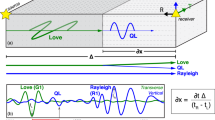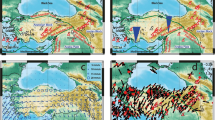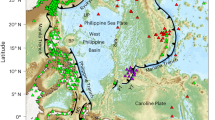Abstract
The D″ shell at the base of the Earth's mantle is thought to be a thermal and compositional boundary layer where vigorous dynamical processes are taking place1,2,3,4. An important property of D″ is its seismic anisotropy, expressed as different velocities for horizontally and vertically polarized shear waves that have been diffracted or reflected at the core–mantle boundary5,6. The nature of this anisotropy has been the subject of debate7,8,9,10,11. Here we present an analysis of various seismic phases, generated in the Kermadec–Fiji–Tonga zone and recorded at stations in North America, which reveal a region at the base of the mantle beneath the southwest Pacific Ocean where horizontally propagating vertically polarized waves are slower (by at least 10 per cent) than horizontally polarized waves. This observed anisotropy is an order of magnitude larger than that previously thought to exist in the lower mantle, and corresponds to lateral variations in horizontally polarized shear-wave velocity which are also of about 10 per cent. We speculate that this anisotropy may be the result of the mixing and shearing of strongly heterogeneous material in the boundary layer.
This is a preview of subscription content, access via your institution
Access options
Subscribe to this journal
Receive 51 print issues and online access
$199.00 per year
only $3.90 per issue
Buy this article
- Purchase on Springer Link
- Instant access to full article PDF
Prices may be subject to local taxes which are calculated during checkout




Similar content being viewed by others
References
Doornbos, D. J., Spiliopoulos, S. & Stacey, F. D. Seismological properties of D″ and the structure of a thermal boundary layer. Phys. Earth Planet. Inter. 41, 225–239 (1986).
Knittle, E. & Jeanloz, R. Earth's core-mantle boundary: results of experiment at high pressures and temperatures. Science 251, 1438–1443 (1991).
Kellogg, L. H. & King, S. D. Effect of mantle plumes on the growth of D″ by reaction between the core and mantle. Geophys. Res. Lett. 20, 379–382 (1993).
Loper, D. E. & Lay, T. The core-mantle boundary region. J. Geophys. Res. 100, 6397–6420 (1995).
Vinnik, L., Farra, V. & Romanowicz, B. Observational evidence for diffracted SV in the shadow of the Earth's core. Geophys. Res. Lett. 16, 519–522 (1989).
Lay, T. & Young, C. J. Analysis of seismic SV waves in the core's penumbra. Geophys. Res. Lett. 18, 1373–1376 (1991).
Maupin, V. On the possibility of anisotropy in the D″ layer as inferred from the polarization of diffracted S-waves. Phys. Earth Planet. Inter. 87, 1–32 (1994).
Vinnik, L., Romanowicz, B., Le Stunff, Y. & Makeyeva, L. Seismic anisotropy in the D″ layer. Geophys. Res. Lett. 22, 1657–1660 (1995).
Kendall, J. M. & Silver, P. G. Constraints from seismic anisotropy on the nature of the lowermost mantle. Nature 381, 409–412 (1996).
Matzel, E., Sen, S. E. & Grand, S. P. Evidence for anisotropy in the deep mantle beneath Alaska. Geophys. Res. Lett. 23, 2416–2420 (1996).
Garnero, E. & Lay, T. Lateral variations in lowermost mantle shear wave anisotropy beneath the north Pacific and Alaska. J. Geophys. Res. 102, 8121–8135 (1996).
Dziewonski, A. M. & Anderson, D. L. Preliminary Reference Earth Model. Phys. Earth Planet. Inter. 25, 297–356 (1981).
Schweitzer, J. & Mueller, G. Anomalous difference traveltimes and amplitude ratios of SKS and SKKS from Fiji-Tonga events. Geophys. Res. Lett. 13, 1529–1532 (1986).
Garnero, E. & Helmberger, D. V. Travel times of S and SKS: implication for three-dimensional lower mantle structure beneath the central Pacific. J. Geophys. Res. 98, 8225–8241 (1993).
Li, X. D. & Romanowicz, B. Global mantle shear velocity model developed using nonlinear asymptotic coupling theory. J. Geophys. Res. 101, 22245–22272 (1996).
Grand, S., van der Hilst, R. & Widiyantoro, S. Global seismic tomography: a snapshot of convection in the Earth. GSA Today 7, 1–7 (1997).
Breger, L., Romanowicz, B. & Vinnik, L. Test of tomographic model of D″ using differential travel time data. Geophys. Res. Lett. 25, 5–8 (1998).
Garnero, E. & Helmberger, D. V. Seismic detection of a thin laterally varying boundary layer at the base of the mantle beneath the central-Pacific. Geophys. Res. Lett. 23, 977–980 (1996).
Backus, G. E. Long-wave elastic anisotropy produced by horizontal layering. J. Geophys. Res. 67, 4427–4440 (1962).
Nevsky, M. V. Quasianisotropy of Velocities of Seismic Waves (Nauka, Moscow, (1974). (in Russian).
Levin, F. K. Seismic velocities in transversely isotropic media. Geophysics 44, 918–936 (1979).
Vinnik, L., Breger, L. & Romanowicz, B. On the inversion of Sd particle motion for anisotropy in D″. Geophys. Res. Lett. 25, 679–682 (1998).
Kind, R. & Mueller, G. Computations of SV waves in realistic Earth models. J. Geophys. 41, 142–162 (1975).
Garnero, E. & Helmberger, D. V. Avery slow basal layer underlying large-scale low-velocity anomalies in the lower mantle beneath the Pacific; evidence from core phases. Phys. Earth Planet. Inter. 91, 161–176 (1995).
Williams, Q. & Garnero, E. Seismic evidence for partial melt at the base of Earth's mantle. Science 273, 1528–1530 (1996).
Mori, J. & Helmberger, D. V. Localized boundary layer below the mid-Pacific velocity anomaly identified from a PcP precursor. J. Geophys. Res. 100, 20359–20365 (1995).
Karato, S. I. Seismic anisotropy in the deep mantle, boundary layers and the geometry of mantle convection. Pure Appl. Geophys. 151, 565–587 (1998).
Wysession, M. E., Okal, E. A. & Bina, C. R. The structure of the core-mantle boundary from diffracted waves. J. Geophys. Res. 97, 8749–8764 (1992).
Jeanloz, R. in Relating Geophysical Structures and Processes, The Jeffreys Volume 121–127 (Geophys. Mongr. 76, Am. Geophys. Union, Washington DC, (1993).
Vinnik, L., Chevrot, S. & Montagner, J. P. Evidence for a stagnant plume in the transition zone? Geophys. Res. Lett. 24, 1007–1011 (1997).
Acknowledgements
We thank M. Wysession for reviews. This work was partially supported by NSF.
Author information
Authors and Affiliations
Corresponding author
Rights and permissions
About this article
Cite this article
Vinnik, L., Breger, L. & Romanowicz, B. Anisotropic structures at the base of the Earth's mantle. Nature 393, 564–567 (1998). https://doi.org/10.1038/31208
Received:
Accepted:
Issue Date:
DOI: https://doi.org/10.1038/31208
This article is cited by
-
Some remarks on the origin of seismic anisotropy in the D” layer
Earth, Planets and Space (2014)
-
Mantle deformation or processing artefact?
Nature (2003)
Comments
By submitting a comment you agree to abide by our Terms and Community Guidelines. If you find something abusive or that does not comply with our terms or guidelines please flag it as inappropriate.



